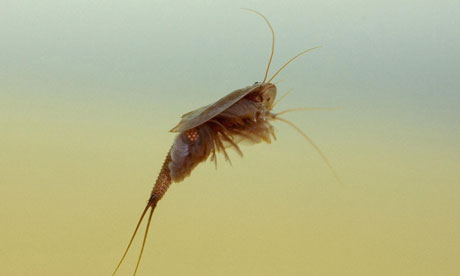
A field near Gretna in Dumfriesshire might not be an obvious place to find the world's oldest living creatures, but a team of scientists has done just that.
Two colonies of a prehistoric shrimp that evolved when the dinosaurs ruled the Earth have been found alive and well in the Caerlaverock nature reserve on the Solway coast.
The discovery has led experts to think there could be more of the little crustaceans, which are listed as endangered species, elsewhere in the area.
The ancient creatures, known as Triops cancriformis or tadpole shrimps, are thought to have the oldest pedigree of any living animal. Fossil evidence suggests they have hardly changed in the more than 200m years that they have been around.
Wild tadpole shrimps can grow to more than 10cm long and are remarkable in surviving three major extinctions in the Earth's history. The shrimps have an extraordinary lifecycle. They live in temporary pools of water in which they lay eggs. When the pools dry out, the adults die off, but their eggs remain dormant until the pools fill up again.
Researchers at Glasgow University discovered the rare shrimps after collecting samples of mud, which were dried out and then made wet again before being placed in glass tanks. A fortnight later Elaine Benzies, a research student, noticed a tadpole shrimp swimming around in one of the aquariums. "I hadn't expected to find it and was just going in to check on the heat and lights. It was great to see everyone in the lab gathering round and peering into the tank to look at this ancient survivor from the past," she said.
Until recently, researchers believed the ancient shrimps lived only in a single pond in the New Forest in Hampshire. Six years ago, Larry Griffin, a scientist at the Wildfowl and Wetlands Trust, discovered what appeared to be an isolated colony of the creatures in a pool at Caerlaverock.
"At the time it seemed that the Caerlaverock colony was a vulnerable historic outlier," he said. "But now that we know how this curious creature survives, we have realised that there's a good chance there are more populations out there.
"Triops matures rapidly and produces hundreds of eggs in just a couple of weeks. The pond they live in may dry out, but the eggs can survive in the mud for many years. Although in the UK they are all females, they have both male and female reproductive parts, so just one egg needs to survive to regenerate a whole population."



Reader Comments
to our Newsletter